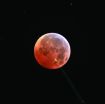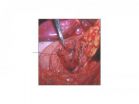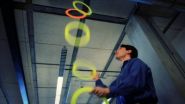(Press-News.org) Strange events have long been linked to nights of a full moon, though careful scrutiny dispels any association. So, when signals bounced off the lunar surface returned surprisingly faint echoes on full moon nights, scientists sought an explanation in reason rather than superstition. Still, the most compelling evidence arrived during another event that once evoked irrational fears—on a night when Earth's shadow eclipsed the full moon.
Tom Murphy, a physicist at UC San Diego, is among the scientists who have aimed laser beams at suitcase-sized reflectors placed on the moon by Apollo astronauts and unmanned Soviet rovers. By precisely timing the light's return to Earth, Murphy can measure the distance from here to the moon with millimeter precision.
Lunar ranging, as this is called, has revealed that the moon is slowly spiraling away from us and suggested that it has a molten core. Murphy's group is using precise measurements of the changing shape of the lunar orbit to subject Einstein's theory of general relativity to the most stringent test yet.
Over time, signals returned by the reflectors, faint to begin with, have faded. The project Murphy leads at Apache Point Observatory in New Mexico sends laser pulses of 100 quadrillion photons, of which, on average, a single lonely photon returns – if any at all. Earth's atmosphere nudges some photons off target so that they hit the lunar soil, and the reflectors slightly diffract the returning beam so that most miss the telescope when they return.
Even after accounting for these losses, Murphy's team records ten times fewer photons than they expect. And on full moon nights it's even worse, dropping to just 1 percent of the predicted performance. Other observatories are unable to detect any returned signal on full moon nights.
The team jokingly dubbed this lousy performance "the full-moon curse," Murphy says. "For a while we thought we were just victims of bad luck, but the trend continued, month after month."
Murphy thinks accumulated moon dust could account for the diminished returns, which could spell bad news for plans to place telescopes up there. Although there's no wind on the moon, electrostatic forces and a constant bombardment by tiny meteorites could have kicked up some of the lunar dust to coat the surface of the clear glass prisms arrayed in each reflector.
Light must pass through the surface of each prism twice—on the way in and on the way back out. A dusting that covers 50 percent of the glass would be enough to account for the dimming of the return signal they observe on most nights, Murphy calculates.
But something else, something in addition to simple obscuration is needed to account for the dramatic drop on full moon nights. Murphy thinks it's heat.
The prisms are sunk a bit into cylinders so that the sun only fully illuminates them when it shines straight in. Because the arrays face Earth, that only happens on full moon nights. When it does, the dark dust of the lunar regolith would heat up, setting up a thermal gradient between the surface and the depths of the prisms. That would degrade their performance by altering the refractive index, turning the prism into an unintentional lens and diverging the returning light so that even fewer photons return to the telescope.
It's a beautiful idea because it generates a thing scientists probably love most: a testable prediction. If the poor performance on full moon nights resulted from heating of the surface of the cubes, turning off the light should boost the signal as soon as the surface cools so that the temperature throughout the cubes is uniform.
All you'd have to do is turn off the Sun. Or wait for the Earth to pass between the Sun and moon, as it does during a lunar eclipse. On the night of December 21, 2010, Murphy's team was fortunate to have decent observing conditions during a lunar eclipse. For five and half hours, they ranged lasers from the three Apollo reflector arrays and a fourth mounted on a Soviet rover (once thought lost for good) as the edge of Earth's shadow passed by each in turn and as they re-emerged one-by-one into full sunlight.
As predicted, they saw a tenfold spike in performance as the celestial light switch was thrown, restoring the signal to levels they see on other nights, the team recently reported in the scientific journal Icarus.
So why, skeptics might wonder, if moon dust is moving about, can the boot prints left by astronauts decades ago still be seen? Murphy has a calculation for that too: at the rate of deposition that must have occurred to obscure the reflectors, it would take tens of thousands of years.
INFORMATION: END
Source of 'moon curse' revealed by eclipse
2014-02-11
ELSE PRESS RELEASES FROM THIS DATE:
Study: Resilience in parents of children undergoing stem cell transplant
2014-02-11
A child's illness can challenge a parent's wellbeing. However, a study recently published in the journal Biology of Blood and Marrow Transplantation shows that in the case of a child's stem cell transplant, parents feel increased distress at the time of the procedure, but eventually recover to normal levels of adjustment.
"Across all study groups, what we basically showed is that parents are resilient. Overall, parents get better over time," says Jennifer Lindwall, PhD, assistant professor of psychiatry at the CU School of Medicine, teaching partner of the University ...
Data on today's youth reveal childhood clues for later risk of STDs
2014-02-11
Here's yet another reason to focus on kids' early years. Children who grow up in well-managed households, enjoy school, and have friends who stay out of trouble report fewer sexually transmitted diseases in young adulthood, according to a new analysis.
The findings, from University of Washington longitudinal surveys of nearly 2,000 participants, suggest that efforts to curb the spread of sexually transmitted diseases should begin years before most people start having sex.
"Pay less attention to the sex aspect of this and think of the larger context," is lead author ...
Targeting tumors: Ion beam accelerators take aim at cancer
2014-02-11
EVENT: Advances in the design and operation of particle accelerators built for basic physics research are leading to the rapid evolution of machines that deliver cancer-killing beams. Hear about the latest developments and challenges in this field from a physicist, a radiobiologist, and a clinical oncologist, and participate in a discussion about cost, access, and ethics at a symposium organized by the U.S. Department of Energy's Brookhaven National Laboratory ("Targeting Tumors: Ion Beam Accelerators Take Aim at Cancer") and at a related press briefing--both to be held ...
Nanoparticles treat muscular dystrophy in mice
2014-02-11
Researchers at Washington University School of Medicine in St. Louis have demonstrated a new approach to treating muscular dystrophy. Mice with a form of this muscle-weakening disease showed improved strength and heart function when treated with nanoparticles loaded with rapamycin, an immunosuppressive drug recently found to improve recycling of cellular waste.
The study appears online in The FASEB Journal.
The investigators, including first author Kristin P. Bibee, MD, PhD, looked at a mouse model of Duchenne muscular dystrophy, the most severe inherited form of the ...
Child abuse rises with income inequality, study shows
2014-02-11
ITHACA, N.Y. – As the Great Recession deepened and income inequality became more pronounced, county-by-county rates of child maltreatment – from sexual, physical and emotional abuse to traumatic brain injuries and death – worsened, according to a nationwide study by Cornell University.
The income inequality-child maltreatment study, to be published in the March 2014 edition of the peer-review journal Pediatrics, covers all 3,142 American counties from 2005-09, and is one of the most comprehensive of its kind and the first to target child abuse in places with the greatest ...
I smoke, but I'm not a smoker
2014-02-11
While smoking among California adults has dramatically declined in recent decades, researchers at the University of California, San Diego School of Medicine report there is a surprisingly large number of people who say they use cigarettes, but don't consider themselves to be "smokers."
Writing in the February 5 online issue of Tobacco Control, Wael K. Al-Delaimy, MD, PhD, professor and chief of the Division of Global Health in the UC San Diego Department of Family and Preventive Medicine, and colleagues estimate that, in 2011, almost 396,000 Californians (12.3 percent ...
Dartmouth study provides first global evidence that foreign aid boosts public opinion
2014-02-11
A study by Dartmouth and Australian researchers provides the first empirical evidence using data from a variety of countries that foreign aid can greatly improve foreign public opinion of donor countries.
The findings are based on a U.S. foreign aid program targeting HIV and AIDS -- the President's Emergency Plan for AIDS Relief (PEPFAR) -- that has substantially improved public perception of the United States in the more than 80 developing countries receiving the aid. But the findings have broader policy implications for an emerging international order in which major ...
Game changer: Biomarker identified for noncancerous pancreatic cysts
2014-02-11
INDIANAPOLIS -- Researchers at the Indiana University School of Medicine have discovered a highly accurate, noninvasive test to identify benign pancreatic cysts, which could spare patients years of nerve-racking trips to the doctor or potentially dangerous surgery.
The findings are reported in "Vascular Endothelial Growth Factor, a Novel and Highly Accurate Pancreatic Fluid Biomarker for Serous Pancreatic Cysts" online in the Journal of the American College of Surgeons.
The test, which analyzes fluid from pancreatic cysts, can identify a common type of benign cyst that ...
New target isolated for leukemia drug development
2014-02-11
SAN ANTONIO (February 11, 2014) – There are potentially effective treatments for acute myeloid leukemia (AML), but they only work in 20 to 40 percent of cases. In a paper published today in Leukemia, a Nature journal, a UT Health Science Center researcher has pinpointed a protein that could play a key, previously unknown role in the development of pediatric AML — promising new information in the quest to treat and cure childhood leukemias.
AML starts at the point when cells mature into different kinds of blood cells. In AML, the cancerous cells grow and proliferate in ...
No clowning around: Juggling sheds light on how we run
2014-02-11
Juggling may seem like mere entertainment, but a study led by Johns Hopkins engineers used this circus skill to gather critical clues about how vision and the sense of touch help control the way humans and animals move their limbs in a repetitive way, such as in running. The findings eventually may aid in the treatment of people with neurological diseases and could lead to prosthetic limbs and robots that move more efficiently.
The study was published online recently by the Journal of Neurophysiology and will be the cover article in the journal's March 2014 print edition.
In ...




